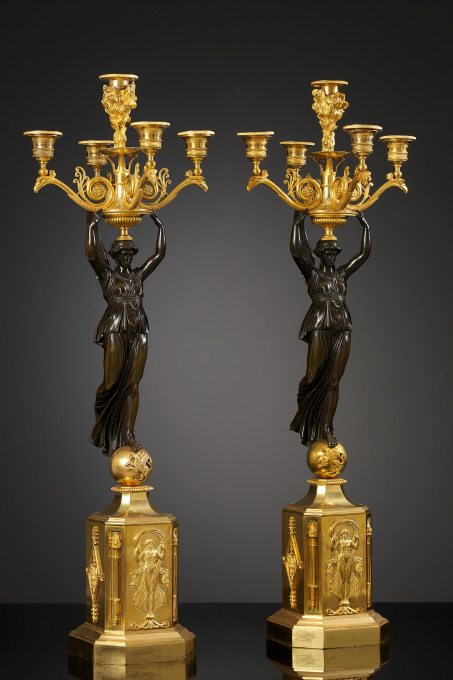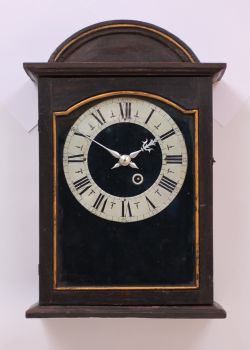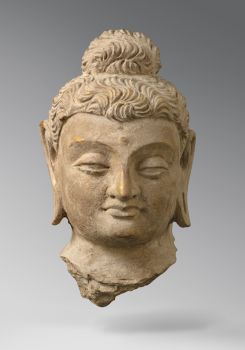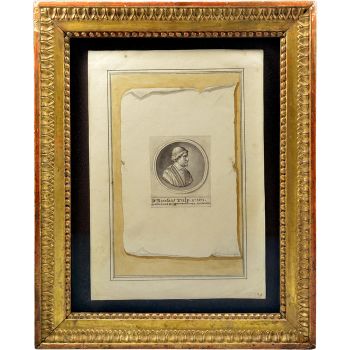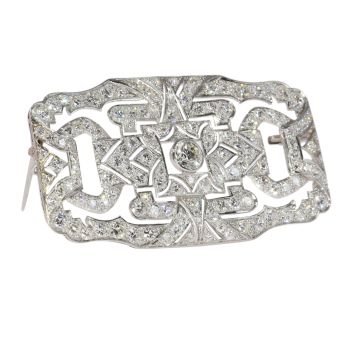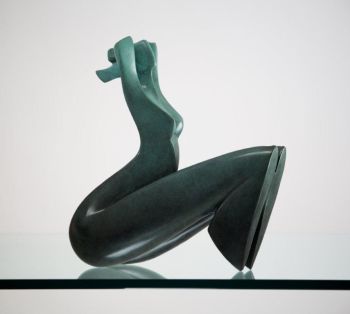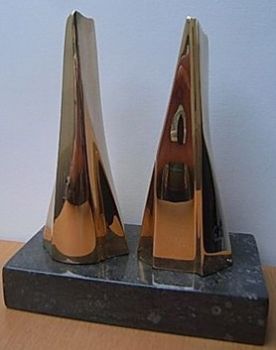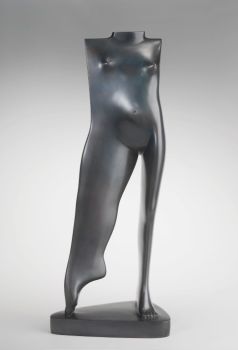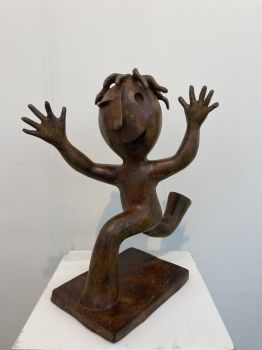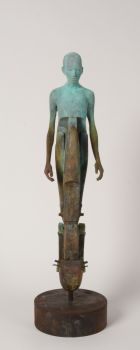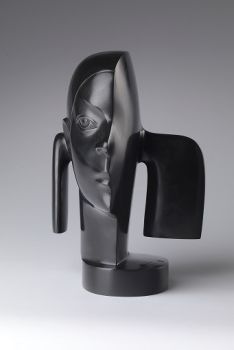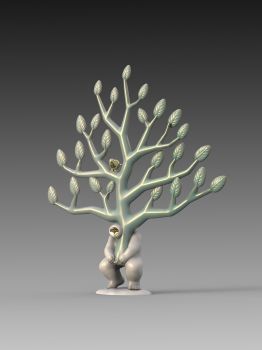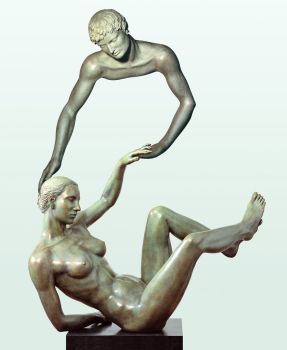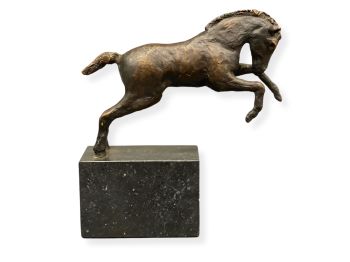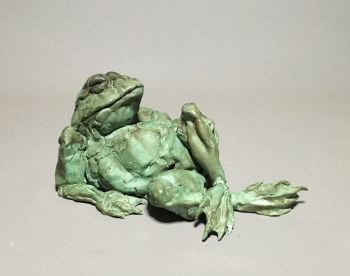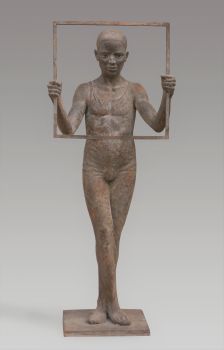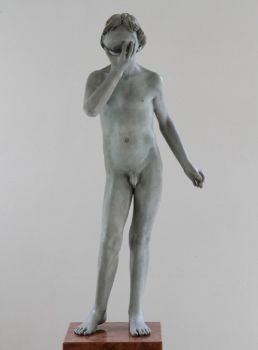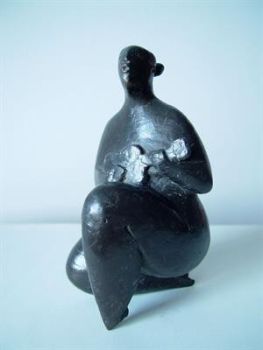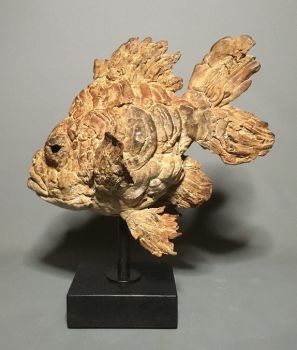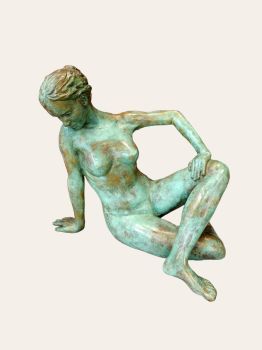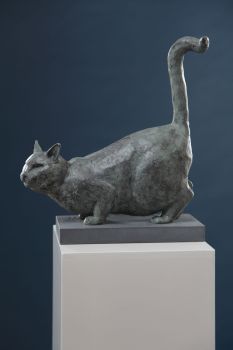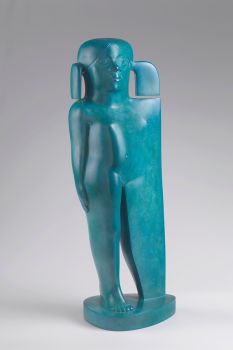A pair of Empire Candelabra 1810
Artista Sconosciuto
BronzoMetallo
75 cm
Attualmente non disponibile tramite Gallerease
- A proposito di opere d'arteA magnificent pair of Empire gilt and patinated bronze five-light candelabra each with the stem formed as an ancient winged priestess with her hands held aloft as she supports the vase on her head. This vase supports four branches that end in birds heads with each a candleholder on top. The priestess standing on a gilt bronze globe with a representation of Pegasus rearing on hind legs. The globe rests on a square truncated plinth mounted with Karyathides and diamond shaped ornamented cartouches with Imperial eagles in the centre. The truncated corners are ornamented with torches.
These sumptuous candelabra are identical in design to a known pair in the former Palais de Tuilleries. The overall design of the candelabra embodies the spirit of the Empire. The priestesses refer to the goût Égyptienne, as inspired by Napoleons Egyptian campaigns. The eagles pay reference to Napoleon’s reign and the representation of Pegasus symbolyses fame. The globe is symbol of the sovereignety over the world.
Although the maker is unknown and none of the above examples bear a maker's mark their design compares with other candelabra and bronzes made by two of the Empire's most celebrated bronziers namely Pierre-Philippe Thomire (1751-1843).
Marie-France Dupuy-Baylet, L'Heure, Le Feu, La Lumière, Les Bronzes du Mobilier National 1800-1870, 2010, pp. 166-167 - A proposito di opere artista
Può succedere che un artista o un creatore sia sconosciuto.
Alcune opere non sono determinate da chi sono state realizzate o sono state realizzate da (un gruppo di) artigiani. Esempi sono statue dell'antichità, mobili, specchi o firme non chiare o leggibili ma anche alcune opere non sono affatto firmate.
Inoltre puoi trovare la seguente descrizione:
•"Attribuito a …." A loro avviso probabilmente opera dell'artista, almeno in parte
•“Studio di ….” o “Officina di” A loro avviso un'opera eseguita nello studio o nella bottega dell'artista, eventualmente sotto la sua supervisione
•“Cerchio di…” A loro avviso un'opera del periodo dell'artista che mostra la sua influenza, strettamente legata all'artista ma non necessariamente al suo allievo
•"Stile di..." o "Seguace di..." A loro avviso un'opera eseguita nello stile dell'artista ma non necessariamente da un allievo; può essere contemporaneo o quasi contemporaneo
•“Modalità di…” A loro avviso un'opera nello stile dell'artista ma di epoca successiva
•"Dopo …." A loro avviso una copia (di qualsiasi data) di un'opera dell'artista
•“Firmato…”, “Datato…” o “Iscritto” A loro avviso l'opera è stata firmata/datata/inscritta dall'artista. L'aggiunta di un punto interrogativo indica un elemento di dubbio
•"Con firma....", "Con data...", "Con iscrizione..." o “Riporta firma/data/iscrizione” a loro avviso la firma/data/iscrizione è stata aggiunta da qualcuno diverso dall'artista
Artwork details
Related artworks
- 1 - 4 / 12
Artista Sconosciuto
Set Franse Empire Pendules / Empire Lectura penduleearly 19th
Prezzo su richiestaKuipers Kunst & Antiek
Artista Sconosciuto
Set of eight gouache drawings1799 - 1801
Prezzo su richiestaRobert Schreuder Antiquair
Artista Sconosciuto
Braccialetto di diamanti del XVIII secolo con intagli di 2000 anni1790
€ 23.000Adin Fine Antique Jewellery
 A cura di
A cura diDanny Bree
1 - 4 / 15 A cura di
A cura diDanny Bree
Artista Sconosciuto
The Stamford Raffles Secretaires.1800 - 1813
Prezzo su richiestaZebregs & Röell - Fine Art - Antiques
Johannes La (le) Blanck
Un set di ampolle d'argento olandese a doppio uso1786
Prezzo su richiestaJacob J. Roosjen SRI
Artista Sconosciuto
UN CONTENITORE PER DOCUMENTI DELLO SRI LANKA IN ARGENTO DORATO19th century
Prezzo su richiestaZebregs & Röell - Fine Art - Antiques
1 - 4 / 24Artista Sconosciuto
The bell of the VOC fortress in Jaffna, Sri Lanka1747
Prezzo su richiestaZebregs & Röell - Fine Art - Antiques
 A cura di
A cura diDanny Bree
1 - 4 / 24

